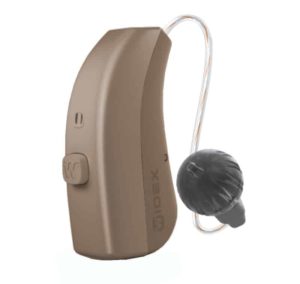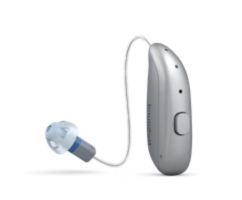Receiver In Canal Hearing Aids (RIC / RITE / RIE)
A Little Hearing Aid History
The Nicolet Corporation created the first commercial digital hearing aid in 1987. It was a body-worn device with a wire connection to an ear transducer. The Nicolet Corporation’s hearing aid was not a commercial success and the company went out of business. But their product development started a rivalry between other companies to create more effective hearing aids. In 1989, a digital behind-the-ear (BTE) hearing aid was launched.
Bell Laboratories contributed to the advancement of digital hearing aids by developing a hybrid digitally adjustable analog instrument. Bell used digital circuits to control a two-channel compression amplifier. AT&T, the parent company of Bell Labs, sold the rights to their technology to GN/Resound in 1987. When ReSound released this new technology to the market, it was an instant success.
Based on the success of the ReSound product, other companies developed digitally adjustable analog hearing aids, with filters, and limiters. The benefits of this new technology included storing sound settings, different settings for varying acoustic environments, and multi-channel compression.
Next came the fully digital hearing aid. Oticon developed the first 100% digital instrument in 1995, but only distributed it to audiological centers for research. In 1996, Widex introduced the Senso. The Widex Senso was the first commercially successful, all-digital hearing aid. After the success of the Widex Senso, Oticon launched their own digital product, the DigiFocus.
Modern digital hearing instruments are now fully programmable and are able to regulate their sound output on their own without the need of separate control devices. Hearing aids can now automatically adapt themselves to different sound environments that they are in.
“Made for iPhone” and Android instruments are now common to the market.
Receiver In Canal (RIC) Hearing Aids
The RIC hearing aid is a newer development and is suitable for most hearing losses.
Compared to the traditional behind-the-ear (BTE) style, the receiver (speaker) of the RIC is placed on the ear-tip instead of in the housing, thereby reducing the housing size.
RIC’s consists of three primary parts: The housing, which sits behind the ear, a thin ear wire connecting the housing to the receiver, and the receiver (speaker), which is in the ear canal.
RIC’s are discreet, extremely versatile, and available for almost any degree or type of hearing losses.
In 2001, two patent’s were filed under the name “Hear-Wear” by the owners of SeboTek Hearing Systems. These new designs (Post-Auricular-Canal or PAC) changed the industry. Once the benefits of the Hear-Wear patents were recognized, other manufacturers followed suit with similar products. The industry as a whole chose not to use the PAC name, but simply called this technology as RIC (Receiver-In-Canal), RITE (Receiver-In-The-Ear) or RIE (Receiver-In-Ear).
The RIC design was more than just the invention of a new style, it was revolutionary step for the entire industry. This new design provided for entirely new fitting methods resulting in improved acoustics, comfort, cosmetic appeal, and wearer satisfaction.
Most major manufacturers offer RIC’s. In 2018, RIC’s accounted for 72.5% of all hearing aids sold. The trend toward more RIC/RITE/RIE fittings continues. As of 2019, RIC’s made up over three-quarters (78.4%) of all units sold in the United States.
Common Repairs
The most common repair issue with RIC’s are the same as with all other hearing aids, regardless of style or manufacturer. Receiver (speaker) failure itself is the most common issue. But, repairing or replacing the RIC receiver is usually much easier than any other style of hearing aid. Replacing a receiver in a RIC is usually pretty simple. With Widex and some other hearing aid manufacturers, simply unplugging the old receiver from the housing and plugging in the new one. In the case of some other brands, you may need to slide out or remove a retention pin to remove the old receiver, then plug in the new receiver and secure it by reinserting the retention pin. You can find instructional videos online on this process.






This Post Has 2 Comments
Very interesting and informative article. Thank you. I learned a lot.
Definitely a game changer in sound quality and comfort.